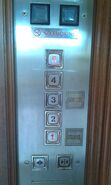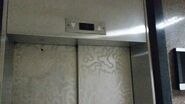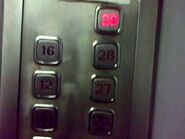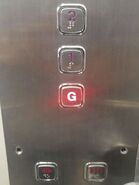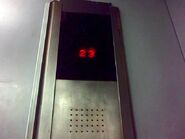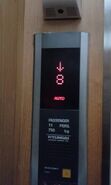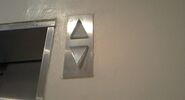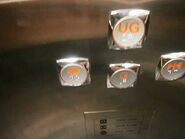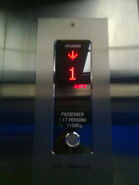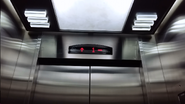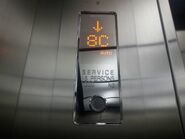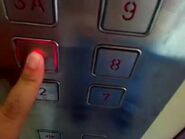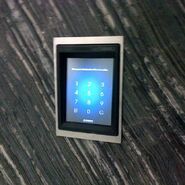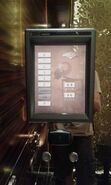This is a list of Hyundai elevator fixtures.
1984 to 1989
Square or barrel buttons
A lot of old Hyundai elevators used either square or barrel shaped buttons with a protruding metallic square frame and a red illuminating number or symbol in the middle of the button.
Round buttons
A very rare button variation. These are white buttons which lights up entirely and has a black frame. These buttons resembles a bit like the buttons used by Mitsubishi and Westinghouse (in the United States) elevators in the 1980s.

觀塘越秀工業大廈HELCO升降機;HELCO elevator @ Yue Xiu Industrial Building, Kwun Tong
1980s Hyundai freight elevator with round buttons in Hong Kong (video by: SC Miles)
Touch sensitive buttons
Hyundai also made touch sensitive buttons which are square with a wide illuminating halo. These buttons are extremely rare.
Floor indicators
Most old Hyundai elevators used floor indicators with 7-segments displays. For the exterior, there are two triangle shaped hall lanterns, with the number display in between them. If the hall station has a floor indicator, there would be two small triangle shaped arrows above the floor indicator. There is also an analogue-style hall floor counter which resembles 1970s-1980s Mitsubishi analogue floor counter, but this is very rare.
1990s to early 2000s
Buttons
Black square buttons
These buttons light up yellow orange when pressed.
Glass buttons
These are barrel-shaped buttons made of glass with a silver halo. They light up red when pressed. These buttons were discontinued sometime in the mid 2000s.
Type 30
These are stainless steel barrel-shaped buttons which light up red when pressed. They can have braille marks under the number or symbol as an option.
Old barrel shaped buttons
These buttons look and press like Dewhurst's older US89 Compact buttons used in the 1980s and 1990s, except that it has a halo and an illuminating number/symbol in the middle. These buttons are usually found in older Hyundai elevators from the early 1990s.
Floor indicators
Hyundai started using LED dot matrix floor indicators in the early 1990s. These indicators have a very similar LED number/letter pattern to Dover's LED pattern that is commonly used in their Impulse fixtures. They also features a unique animating directional arrow in which the arrow "jumps" every time the car is moving. Hyundai also used 7-segments display with simple triangle directional arrows, but this is very rare. Also, all elevators installed from the early 1990s onward have illuminated "AUTO" lamp on the indicators (both inside and outside), which stays illuminate when the elevator is set to normal operation, even when it is idle and not in use.
Hall lanterns
Hyundai's standard hall lanterns used in the 1990s are triangle shaped, and they would light up green for up and red for down. Each lenses are slightly tilted, the down lens is tilted upward while the up lens is tilted downward, similar to the hall lanterns used by Schindler from the 1970s to 1990s. Apart from that, there are also elevators with custom designed lanterns in various shapes, usually made according to the client's requests.
2000s to mid 2010s
Buttons
Type 30
Hyundai continued making the Type 30 buttons until they were completely discontinued sometime in the early 2010s.
Type 40
A lot of Hyundai elevators installed between the mid 2000s to mid 2010s use these buttons, which are round concave buttons encased in a silver barrel shaped frame. Both the halo and number/letter light up red when the button is pressed. These buttons always have braille marks under the lamp. Around the early or mid 2010s, Hyundai stopped making these buttons, and continued on with the Type 41 and the newly released Type 64 buttons as the successor of Type 40.
Type 41
These are round concave buttons with both an illuminating halo and number/letter, and braille marks. Much like the Type 40 buttons but without the silver barrel shaped frame. Type 41 buttons are still made by Hyundai, and they are the successor of the now discontinued Type 40.
Type 50/51
These are rectangular convex buttons with an orange illuminating lamp on the left, as well as a red illuminating number/letter on the button itself. These buttons might have been discontinued.
Floor indicators
LED dot matrix
Hyundai continued using floor indicators with LED dot matrix display as a standard feature. These indicators comes in several different shapes, and can be on the hall/car station or above the hall/car door (overhead). There are two LED colors; one is red which are normally found in geared traction (STVF) and MRL (SSVF/YZER) models, and the second one is orange which ones are normally found in Hyundai LUXEN (LXVF), iXEL and The EL elevators. By default, the indicators comes with two numbering digits (excluding the arrow above them), but some indicators can be configured to have three digits to display custom floor numbers.
- Red LED
- Orange LED
LCD display
Besides LED displays, Hyundai also use LCD screens for the floor indicators. These indicators has a blue background, white number/letters, and an animating V-shaped arrow in the same style as the LED arrows.
Third party/generic and custom fixtures
Some Hyundai elevators installed in Indonesia and Thailand use third party/generic fixtures made by Shanghai STEP. Some examples have the standard Hyundai LED indicators but STEP EB960 buttons. There are also a few Hyundai elevators having STEP EB210 buttons and STEP SM-04-HSC LED floor indicators, these are usually found in Indonesia.
Mid 2010s to current
Buttons
Type 60
These are round convex buttons with green illumination. They don't have braille marks.
Type 64
These are round silver concave buttons with an all-green or orange (optional, a very rare variant) illumination. It is intended to replace the current Type 40 series buttons. In some installations, the door open button is wider than the rest of the buttons. This is intended to avoid confusion with the door close button. There are also elevators in which the button for the main/exit floor has a green ring to make passengers easier to go to the main floor and/or leave the building.
Type 66
These buttons are the same as Type 64, except that the arrow light up white instead.
Type 70
This is a bar shaped button with white illuminating symbol, and has a green illuminating line under the symbol.
Type 80
This is a flushed rectangle button with white illuminating symbol/letter and green illuminating halo.
Type 82
These are the same as Type 80 except that they have an all-green illumination.
Type 90
These are round touchless buttons that are flushed into the panel. The halo light up green when the buttons are touched.
Type 9A
These buttons are shaped like real number/letter/symbol, and protrudes from the panel. They light up either yellow orange (standard) or green (optional, a very rare variant)
Type 20
These are square buttons with illuminating halo and number/symbol.

Nyundai servie elevator at PMI Afiat Hospital bogor
Hyundai elevator with Type 20 buttons in Bogor, West Java, Indonesia.
Type 21
These buttons look the same as Type 64 except that they are convex instead of concave.

2019.08.23 Posh Korean-style elevators in Surabaya-0
Hyundai elevators with Type 21 buttons in Surabaya, Indonesia (video by: Devil Black Soup Guy)
Type 40 and 41
By the late 2010s, both Type 40 and 41 buttons are still available but not as common as they were before. They appear to be exclusive for the WBST series (geared traction) elevators.
Floor indicators
Red/Orange Dot-Matrix Indicators
Hyundai still continue to make Red/Orange Dot-Matrix Indicators.
White Dot-Matrix Indicators
This Indicator was introduced in the Late-2010's which has a scrolling floor Indicator and uses White Light
LCD Indicators
Also in the Late-2010s,Hyundai also Introduced the LCD Indicator,This Indicator has white lights and uses Century Gothic Font for the numbers with Cool Animated Arrow
Shanghai Hyundai Version
This Indicator is manufactured by Shanghai Hyundai Elevator,It uses a 45-Degree Arrow with purple background
Smart Indicator(wide type)
This is a indicator installed above the car door and same width with the door, featuring white segmented number, orange colored animating arrows, date and time and icons. These icons indicates, located on the left hand side of the indicator, certain features that are implemented and currently active in the elevator, they are:
- CCTV Security (orange box with a camera icon)
- Power Saving (green box with a power plug icon)
- Anti Virus Handrail (green box with a handrail icon)
- Ultrasonic Pest-Repellant (green box with a fly icon being crossed)
Further to the right hand side of the indicator is a unique animation to indicate that an Air Clean Function is being activated in the elevator car.
Smart Indicator(slim type)
This is a indicator installed above the car door and fixed width regardless of the door size, featuring animated light blue led line with new white number and animating arrows on the left hand side of the indicator. These icons indicates, located on the right hand side of the indicator, certain features that are implemented and currently active in the elevator, they are:
- CCTV Security (white lined box with a camera icon)
- Power Saving (white lined box with a power plug icon)
- Ozone-free negative ion air purifier (white lined box with a fan and negative ion icon)
- Ultrasonic Pest-Repellant (white lined box with a mosquito icon being crossed)
This indicator was a part of the Vivaldi design trim, but it can be installed independently.
These indicators are quite common in South Korea, but extremely rare in other countries. Smart Indicators are optional indicators that belongs to the "Deluxe" indicator category.
Special Indicators
Hyundai also make Special Floor Indicators, there is 3 types of Indicators Available
- A Filled-Colour Dot-Matrix with Gradient Liked Arrow
- A Outlined Colour Dot-Matrix with Dot-Liked Arrow
- A Outlined Colour Dot-Matrix with Fading Lines
Touchscreen
These touchscreen are often used in elevators working with HELIAS destination dispatch as hall stations. They are also used on car stations for non-HELIAS elevators.
Destination Selecting System keypads
These are keypads used for Hyundai elevators with Hyundai Destination Selecting System.
Fixtures used on American Hyundai elevators
Hyundai elevators installed in the United States have two types of buttons; one is round white which resembles round Innovation Universal buttons, and one is a round solid metal with a red dot on the center but they are only being used on the hall station (it is unknown of those buttons are also used on the car station). Floor indicators are simple rectangular floor counter with red LED dot-matrix display.
Custom and third-party indicators
Some modern Hyundai elevators still use fixtures made by Shanghai STEP. Elevators with custom made fixtures also exist.
Chimes
In 1990s to early 2000s, Hyundai used two stage chimes for upwards and one stage chimes for downwards. The chimes have two versions with varying pitches. The high-pitched chime is prevalent in elevators before early 2000s while a modified version of the chime is prevalent in elevators around 2000 to 2005. The modified version was available even in the newer versions of Hyundai elevators, although rare. Some elevators can only have one stage or two stage chimes in both upward and downward, or the chimes are shuffled unlike the default installation.
Hyundai elevators installed around 2005 used four-stage chime. Although the chime is known to be used in elevators installed between 2006 and 2011, the chime was actually first used in Hyundai elevators that use Shanghai STEP fixtures. It is very similar to older SIGMA and Shanghai Mitsubishi chimes, though high-pitched.
From 2011 onward, Hyundai use two versions of chimes. First is the new four-stage chime, a chime that sounds like being played in a piano. It is a departure from the high-pitched chime played in elevators from 2005 to 2011. The four-staged chime is played in both upward and downward travel. The second is a new two-stage chime more prevalent in elevators with large information texts in indicator (passenger, maximum load, etc). Like the first one, it is played in both upward and downward travel.
Also, some Hyundai elevators manufactured by Shanghai Hyundai (outsourced) since 2016 have very different chimes. The upwards chime is one-stage while the downwards chime is two-stage, reminiscent of Sigma elevators.
In South Korea, there are two standard versions of chimes available, a two-stage chime and a four-stage chime. It is played in both upward and downward. The old-generation chime available in Hyundai elevators installed w/in 1990s were available although it is rare. Since almost all elevators in Korea have voiceover, these two-stage and four-stage chimes are available in other countries and intended to elevators with Hyundai voiceover.
External links
- Hyundai Passenger Elevator brochure (USA) (includes fixtures used in the United States)



